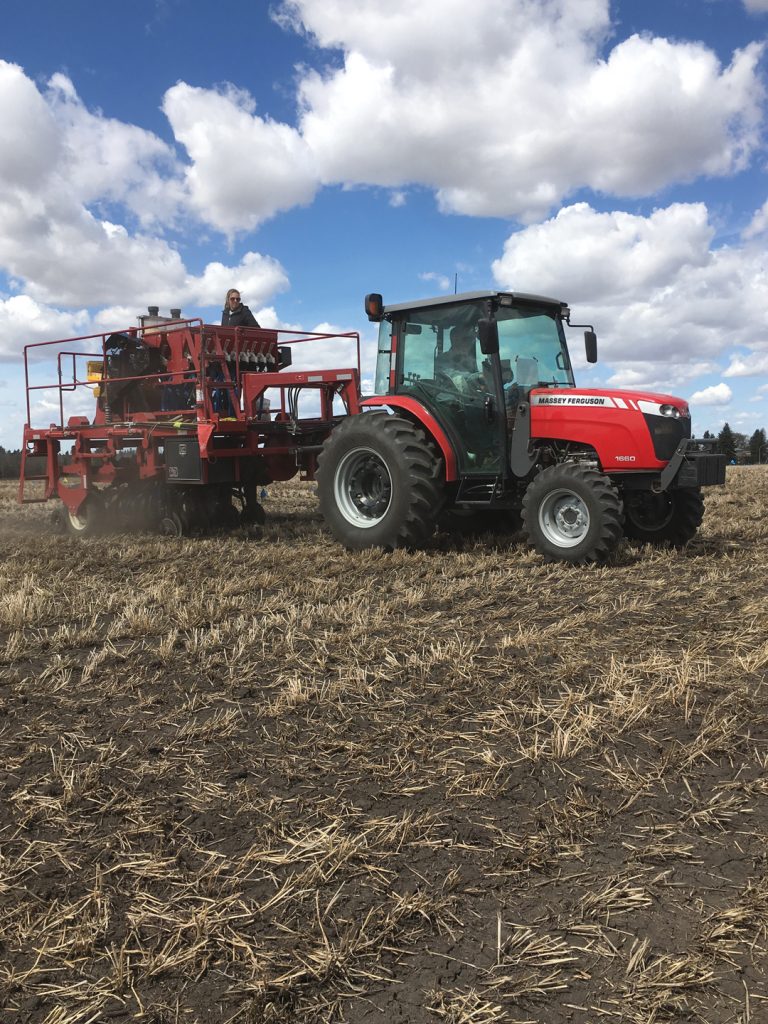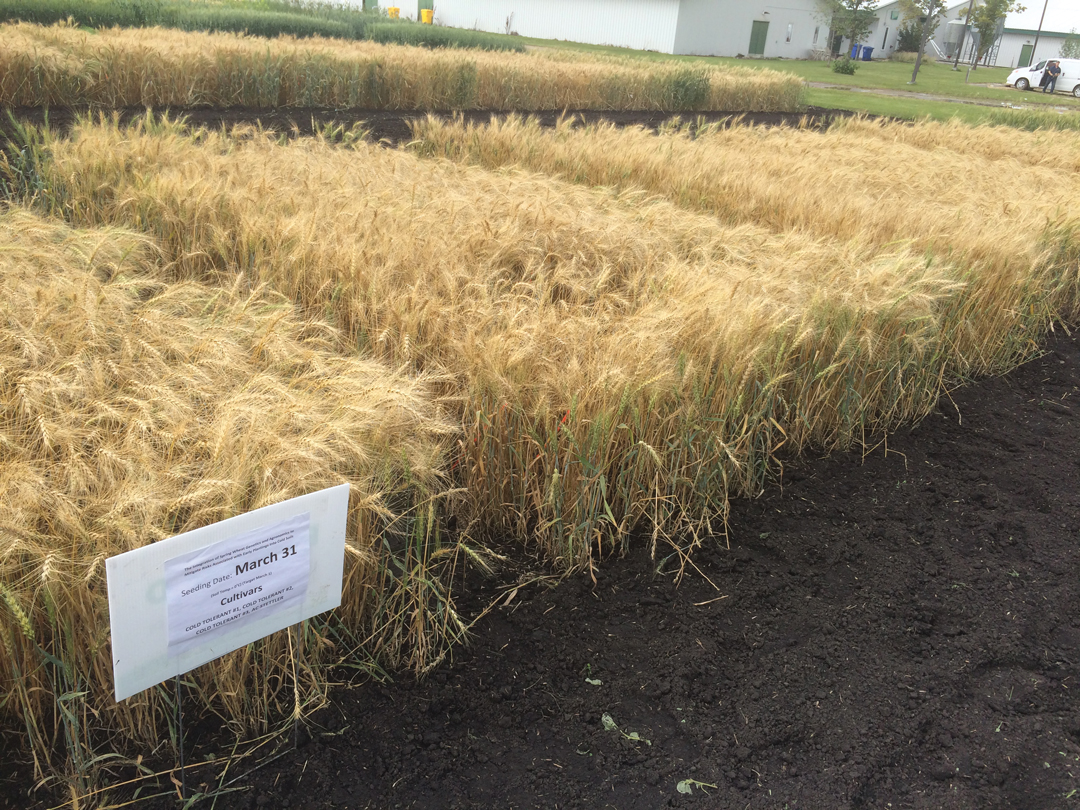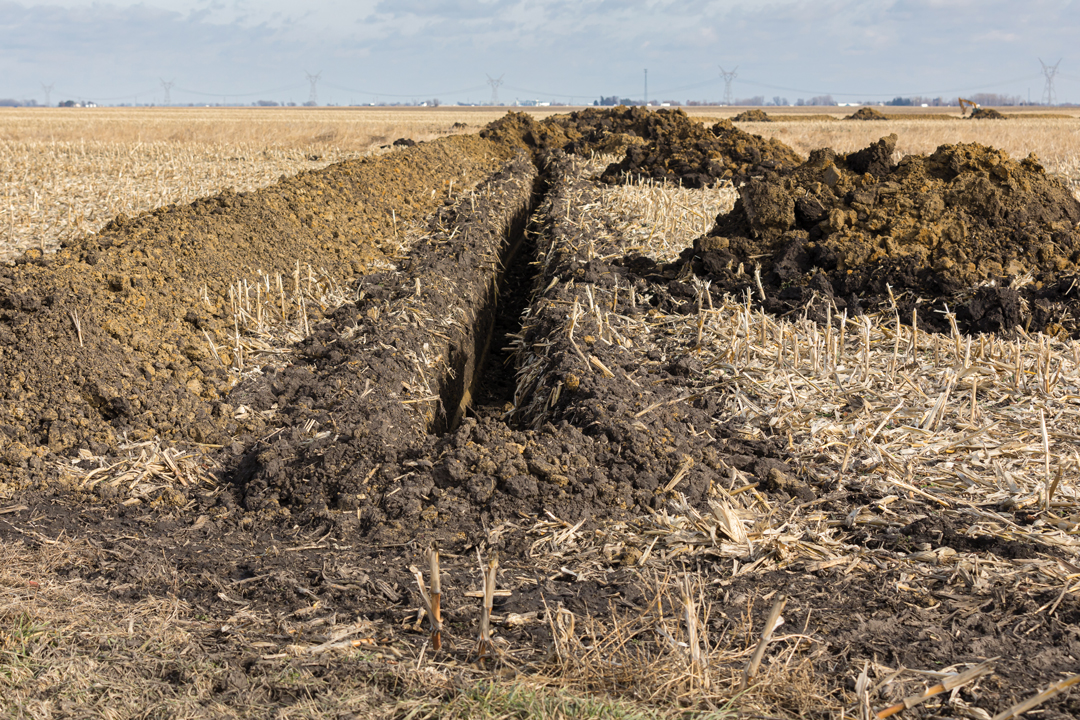FROST BEATERS
BY MELANIE EPP • PHOTOS COURTESY OF GRAHAM COLLIER
Spring wheat is Western Canada’s most significant crop. In the northern Prairies, though, much of the wheat grown for bread ends up being downgraded due to frost damage. This creates difficulties for farmers at harvest, but also impacts their bottom line. Dean Spaner, a University of Alberta Faculty of Agricultural, Life and Environmental Sciences professor, is addressing the problem in a research project funded by the Alberta Wheat Commission (AWC). The initiative will examine early-maturity traits in the hopes of addressing the challenge.
The project will screen varieties of Canadian spring wheat that are not commercially available for genes that provide early maturity, said Spaner. The goal is to develop early-maturing varieties that don’t compromise yield and quality.
Spaner has been the principal wheat breeder at the University of Alberta for 18 years. The institution maintains the most northerly CWRS breeding program in Canada. Location is everything in breeding programs, as it influences regionally important traits by proxy.
“We have a natural selection for earliness because, even if we select for yield, we’re going to be selecting adaptability to this climate, which is among the shortest growing seasons in North America,” said Spaner. The difficulty, though, is high yield and early maturity are negatively correlated, as are high protein and yield.
There are three main genetic pathways that control early maturity: photoperiod response genes, vernalization genes and what are termed “earliness per se genes.” All three assist in regulating flowering time and time to maturation, but the first two are well-known to science. Spaner’s study involves mapping the earliness per se genes to determine if they can be used for selection—to choose appropriate parent plants for breeding. It’s a tricky process, and the work is time consuming. Spaner and his team will screen approximately 100 to 150 CWRS varieties.
In 2018, Spaner and his research team developed five varieties that were approved for registration. One of these, Parata—registered in 2016 and now marketed by SeCan—matures four days earlier than AC Carberry and may be a potential replacement for AAC Redwater.
Lauren Comin, AWC director of research, said Spaner’s work is immensely important to Alberta farmers, especially to those in the northern regions where frost and winter weather tend to come earlier and growing seasons are greatly reduced. There is a wide spectrum of growing environments within Alberta, she said, many of which are subject to unpredictable weather patterns year-round.
“Each year, this is a gamble,” said Comin. “Springs can be too cold or too wet to get in to get seeding early. We have seen snow in practically every month and, certainly, September is no stranger to wet, heavy snows and even frost. 2018 serves as a perfect example of when an early maturing variety may have made the difference between an easy to harvest, No. 1-grade crop and a lodged, frost-damaged mess. Early maturing varieties tip the odds in a producer’s favour when it comes to harvesting a high-quality product,” she added.
A CHANGING ENVIRONMENT
While some folks blame climate change for the variability, Ralph Wright, head of agro-meteorology with Alberta Agriculture and Forestry (AF), said variability is normal. He points to AF’s Alberta Climate Information Service tools available at weatherdata.ca. The resource allows farmers to examine weather variability in their areas. “They can go back to 1961 and see how the frost-free years varied year to year,” said Wright. “They can look for trends, and they can also notice that there can be abrupt changes year to year.”
Frost-free days means the number of days between the last fall day it reaches -2°C to the first day it reaches -2°C again in spring. Wright pointed out that frost impact varies. “A -2°C frost this year may do nothing, whereas a -2°C frost in another time can be way worse, depending on how long the frost lasts, what the moisture content of the air is and what state the plants are in,” he said.
Other factors important for growth is growing-degree days or heat units. “Plants are funny,” said Wright. “It’s very predictable how much heat it takes to grow a plant. We may have 120 frost-free days in a year, but the amount of heat that occurred [during] those will dictate how fast the crop grows to maturity. It’s not just a day thing.
“The only thing that’s normal is variability and that it changes abruptly without any warning,” concluded Wright. “Mother Nature is always throwing curveballs.”

SURPRISING RESEARCH RESULTS
Under the supervision of Dean Spaner and Agriculture and Agri-Food Canada agronomy research scientist Brian Beres, PhD student Graham Collier conducted a series of five ultra-early seeding experiments funded by AWC.
Typically, early seeding date studies have been based on date, but Collier’s experiments looked at soil temperature. In the first experiments, he planted three cold-tolerant varieties, as well as CWRS variety AC Stettler at soil temperatures between 0°C and 10°C in two-degree increments.
AC Stettler performed just as well under early-season cold conditions as cold-tolerant varieties. The latter were spring wheats created by crossing winter and spring varieties that yielded cold-tolerant traits. Although they didn’t exhibit 100 per cent of the cold tolerance that they do when planted as winter wheat, these crosses did provide an increase in tolerance.
“That’s actually really good news for us in terms of implementing an ultra-early seeding system because it means that we don’t need specialized varieties to do it,” said Collier. “We have the genetics available in varieties that we’re already using, so it just becomes a matter of choosing which varieties are best suited to that use.”
The study found that optimal seeding temperature was as low as 2°C. From 2°C to 6°C, there was no yield penalty. Yield was reduced in stands planted at 10°C. At 0°C, a significant decrease in yield was not seen, but the overall stability of the seeding system was compromised.
Zero degrees worked surprisingly well, said Collier. “There was essentially no yield penalty. You’d expect that you’d lose a lot of plants to frost. But the most stable systems were those 2°C to 6°C seeding dates, whereas your variation started to increase quite a bit at 0°C and 10°C.”
The second experiment looked at building an agronomic system around the idea of ultra-early seeding. Here, Collier looked at a seeding date, seeding rate and a couple of cold-tolerant varieties. “There were not any real big surprises coming out of that,” said Collier. “The higher seeding rate, as you can imagine, increased the stability of the system.”
“The single most important factor across the experiment in terms of maintaining yield was seeding rate,” he added.
That optimal seeding rate will differ depending on where it’s planted. The recommendation will be the maximum seeding rate for a given area. As well, the experiment evaluated seeding depths of one inch and two inches and found that depth had no effect.
The results of the first two experiments show great promise. “We’re going to be able to use our conventional spring varieties in an ultra-early system,” said Collier, adding that it’s very important to use an optimized seeding rate, and to plant in the ideal soil temperature range of 2°C to 6°C.”
Soil temperature can be measured using a soil thermometer at a depth of five centimetres at the same time each day. Collier measured at 10 a.m. in his experiments. “The first time you see that your soil is at 2°C at your selected time is when we went ahead and seeded. We started referring to the soil temperature target as a trigger temperature for seeding. There will be variation up and down after that trigger temperature is hit.”
The three additional experiments evaluated residual herbicide systems for ultra-early seeding, various nitrogen-application technologies and a wide variety of genetics for their suitability for ultra-early seeding. Results should be available early in 2020.







Comments